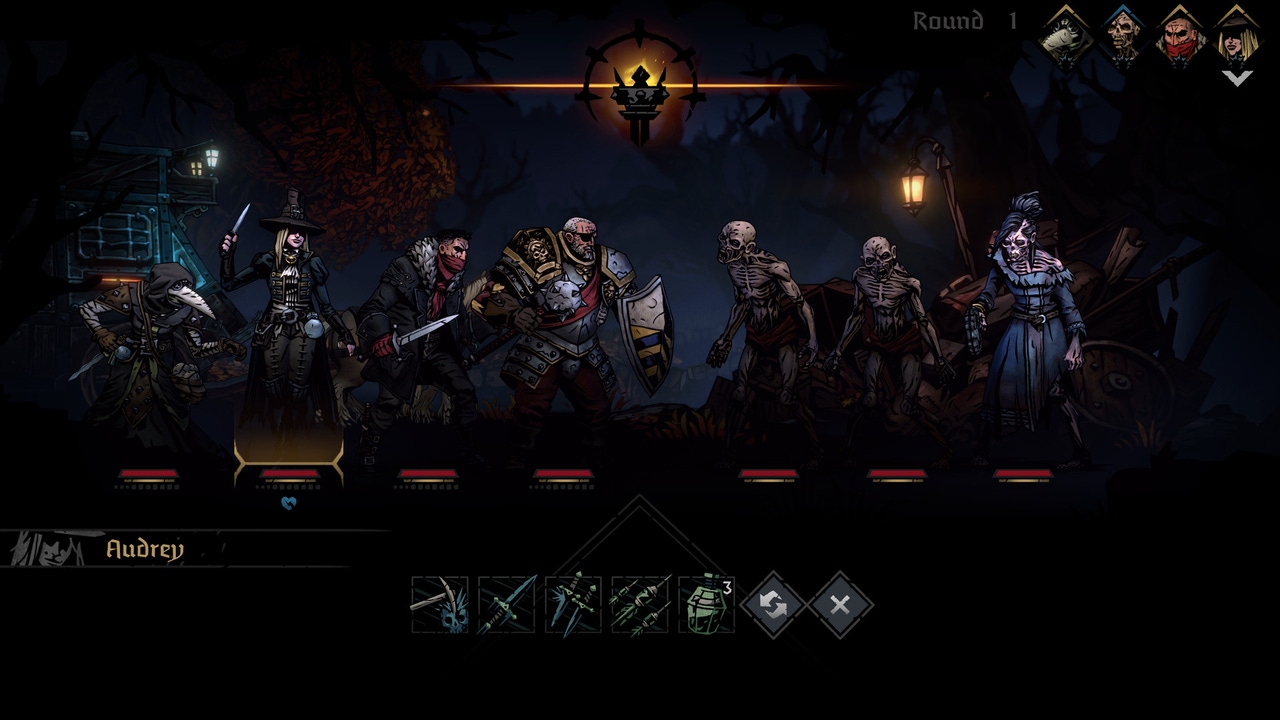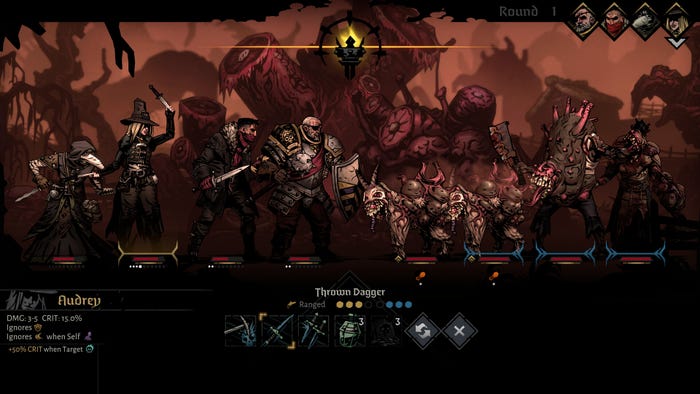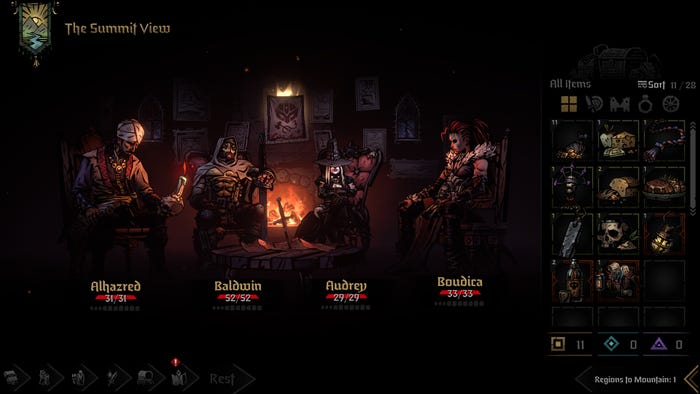Trending
Opinion: How will Project 2025 impact game developers?
The Heritage Foundation's manifesto for the possible next administration could do great harm to many, including large portions of the game development community.

Developer Chris Bourassa talks about the need to do something new with the sequel to Darkest Dungeon, and how a road trip feel (and a switch to a 3D style) brought fresh life to the franchise.

The IGF (Independent Games Festival) aims to encourage innovation in game development and to recognize independent game developers advancing the medium. Every year, Game Developer sits down with the finalists for the IGF ahead of GDC to explore the themes, design decisions, and tools behind each entry. Game Developer and GDC are sibling organizations under Informa Tech.
Darkest Dungeon II sees players returning to a gloomy world where party infighting can be just as lethal as the undead and beasts that are constantly attacking you.
Game Developer spoke with Chris Bourassa, creative and art director for the game, to talk about the "road trip with bickering children" vibe that helped add some exciting new character elements for players to manage, the challenges that came from adapting the first game's 2D art style into 3D without losing its personality, and the way they worked the player’s experience into the unsettling sounds and music of the game.
Who are you, and what was your role in developing Darkest Dungeon II?
I’m Chris Bourassa, creative and art director at Red Hook. I establish the tone and look of the game, design the heroes and monsters, write the script, texture models and draw UI art—whatever needs doing!
What's your background in making games?
I have been a concept artist & art director in games/tv for…25 years at this point?! But I’m very happy to say that the last 11 have been spent at my own company, creating a world that I love very much.

Images via Red Hook Studios
How did you come up with the concept for Darkest Dungeon II?
Darkest Dungeon II was conceptualized as a road trip from hell—an oblique take on some of the mechanics of the first game, aimed at delivering a fundamentally different experience. Rather than being in a static location and building up a town and large pool of heroes, we really loved the reversal of being always on the move with 4 bickering children in the back seat of the car. The evolving social dynamics that can play out in a road trip were also fascinating to us, and we felt they made for a fertile design space.
Tonally, we were excited to explore a more hopeful counterpoint to the original Darkest Dungeon and deliver the message that resilience and determination in the face of adversity is, in itself, the essence of heroism.
What development tools were used to build your game?
Unity, Maya, Substance Painter, Photoshop, and lots of Microsoft Excel.
What interested you about returning to the world of Darkest Dungeon for a sequel? What more did you feel you had to add to the original game's design?
We firmly believe that Darkest Dungeon I succeeded primarily because we chose to build something we loved. But after 6 years of making that game and associated expansions, we really, really didn’t want to make something that was fundamentally identical. At the same time, we genuinely felt excited to explore the Darkest Dungeon world more, but it *had* to be through a different lens in order for us to want to do it. The single most compelling thing about being independent is the freedom to make something that excites and interests you.
Having a breakout hit comes with its own version of the innovator’s dilemma—adherence to a formula and expectation of success could lead to risk averse behavior and milquetoast products. We were determined to avoid that at all costs.
Ultimately, being free to follow our creative intuition is the most important thing to us. It is why we make the games we do. We believe it is far better to have pushed ourselves than to have retread the same ground. While there is always a price to pay when attempting the unconventional, journeying into the unknown makes us better developers and more interesting people.
This game builds upon the art style of the original using 3D visuals and various effects. What challenges did you face in incorporating these new visual elements into the game without straying from the style that made the original special? And what benefits came from these new tools?
Adapting the original game’s art style from the purely hand-drawn 2d art into 3d was a significant challenge. In order to preserve the rough, impassioned quality of the original game’s visuals, the team had to embrace some unconventional production processes in both character and environment production.
Character textures are hand-painted on 3d models using the same brush shapes and parameters as the brushes used in the original Darkest Dungeon. Characters are washed with grit and a subtle gradient to ground them in the world. Lighting is handled with a mix of shaders and real-time lights to bring volume and readability without compromising the comic-book quality that makes the game so distinctive.
Rather than following a traditional 3d production workflow, environment assets in Darkest Dungeon II are drawn in 2d first. A 3d modeler then builds out geometry to support the original art, bringing volume and dimensionality that enhances the linework and painted details. By continuing to focus on hand-drawn textures and using technology to support and enhance the 2d work, characters and environments in Darkest Dungeon II feel like a natural and exciting evolution of the franchise’s unique style.

Images via Red Hook Studios
Can you tell us a bit about the design of the dungeons and new, vast lands players will explore in the game? What thoughts went into creating a sense of greater scope, visually, in the world of Darkest Dungeon II?
I was very excited to turn the dungeons of the first game inside out and conceptualize the overworld itself as a series of distinct, threatening, and memorable biomes. The initial exploration focused on expressing different variations of a nightmare apocalypse, and theming the biomes in such a way as to express different emotional responses to the end of the world.
Being a road trip, we felt that seeing the horizon was integral to the sense of scope and aspiration we wanted players to feel, and this meant that traversal needed to be a 3d space, procedurally generated. There was no shortage of challenges to develop and realize this vision from a visual and technical standpoint, but the net result is a series of sprawling vistas that revel in their repulsiveness.
What thoughts went into creating the creatures that inhabit these new lands and bleak caverns? How did you create monsters that felt they belonged in each wretched landscape?
From the nihilistic burning cities to the gluttonous farmlands, each environment and its associated faction of monsters is designed to reflect a response to the in-game apocalypse.
This thematic grounding allowed me to cluster the enemies into distinct, easily identifiable factions that shared a visual hook. Melted flesh in the fanatics, extra mouths and teeth for the ravenous gentry, clumps of moss and bones for the lethargic, resigned foot soldiers of the forest, and so on.
Having a strong visual connection between members of a faction creates a sense of belonging and elevates the differences between creature clusters. Tying them to their environment allows each biome to feel like a different world within the game and helps bring punchy variety to the play experience.
What ideas go into creating a monster that fits in well with the world of Darkest Dungeon II? Can you walk us through the design of a personal favorite monster?
One of my favorite enemies in Darkest Dungeon II is the Harvest Child boss. It exemplifies our design goals in the sense that is visibly grotesque, unexpected, and has horrific implications beyond its immediate threat.
The Harvest Child is found in the sprawling farmlands of Darkest Dungeon II’s Kingdom, and is an oversized half-born baby emerging from a decorated cornucopia. The enemies in this area are consumed with gluttony and have begun to feast on the preternatural meat stalks that have grown up in the soil (and upon each other). What better way to celebrate the harvest than to worship a child born of a half-eaten mutant mother? Taking the themes of farming and the fall harvest and turning them on their head while embracing their core themes of abundance and rebirth was great fun, and the audio design is unsettling in the extreme.
Having said that, the Harvest Child manages to maintain an odd sense of cuteness, which is carefully used through the Darkest Dungeon rogue’s gallery as a very subtle counterpoint to the overtly gory or grotesque elements.
How did you reshape the heroes so that they would look familiar to the original design while giving them a new look for Darkest Dungeon II?
Design wise, our aim was to ‘grow the heroes up’ a little in terms of their proportions. Rather than the more caricatured take of the original, Darkest Dungeon II’s heroes have been reimagined with a scale ratio that evokes action figures or comic books.
We also made sure to leverage animation as a vehicle to bring Darkest Dungeon II’s characters to life—to express their attitudes, fighting styles, and personalities, all while remaining true to what players of the original Darkest Dungeon had crafted in their imaginations.

Images via Red Hook Studios
Audio was a critical piece of the original game. How did you build upon that for this game?
Darkest Dungeon II’s audio direction was approached like engineering a living organism—that the audio would react dynamically to the choices the player made. For instance, when the torchlight is at its brightest (a mechanic that affects difficulty and modifiers), the ambience is more representative of what the player visually sees. As the torchlight diminishes and darkness sets in the game, the ambience changes and gives way to more ethereal, unseen audio layers.
Music implementation works the same way with different types of enemies presented in a battle—the more threatening the enemy, the more dire the music transposes with every following bar and measure. Driving your battered stagecoach is also dynamically created, sounding heavier and more bloated the more characters with armor are in your party, while sounding lighter and more frail when party members have expired on the journey.
We also ensured that every monster is voiced from unique sources, from stretching out dishwasher cycles to recording newborn babies cries in their first few weeks in the world to manipulating source material from nocturnal animals in Singapore.
What thoughts went into the new narrations for Darkest Dungeon II? How did you create fresh new horrifying things to be said by Wayne June as players make their way through the game?
In the original Darkest Dungeon, the narrator is the player’s Ancestor—a wealthy aristocrat prone to violence, depravity, excess, and sardonic sneering. His lines were great fun to write, but with the sequel we wanted the voice of the game to feel more affirmative and resolute.
Darkest Dungeon II’s Academic is a benevolent guide, encouraging the player in stern axioms and pithy observations. But he is a melancholy character—lamenting the state of the world, and the failings of the protagonist that have resulted in the destructive cataclysm that rages throughout the kingdom. Wayne’s performance captures this complexity perfectly, bringing subtle notes of sadness, thoughtfulness, encouragement, or optimism as the script requires.
What appealed to you about adding the Affinity System to the game? What interested you in exploring relationships between characters, for good or bad? What do you feel this added to the already-stressful experience of playing the game?
The first Darkest Dungeon famously introduced the Affliction System, which was the set of stress-based mechanics that forced players to manage heroes’ mental health. This sequel focuses on hero-to-hero relationships instead of individuals’ reactions to stress. This “Affinity System” system layers intentionally and thematically to the game’s central “Road Trip from Hell” conceit.
The journey is grueling and the player must employ a combination of strategy and tactics (item use, positioning, treatments, etc.) to ensure that the party does not devolve into an angry, distrustful, dysfunctional team. The design intent is for the relationships of the heroes to be an ever-present layer that imbues all other actions in the game with choice and consequence. Choosing who will strike a killing blow or whether to help refugees each has the potential to influence the broader party-emergent narrative. It is important to us that the player must consider the team as a whole and not just each individual hero.
What challenges come from designing a game that is relentlessly difficult, yet still feels compelling to the player? How do you keep this balance in mind throughout the design of Darkest Dungeon II?
One of the signature qualities of Darkest Dungeon is that victory is hard-earned, but the game is actually very fair. “Fair” can feel off-putting to many in this current age of gaming, because so many games are designed to ensure success through dynamic difficulty adjustments, mobile-style game loops, and so on. When we created the first Darkest Dungeon, we drew upon our experiences gaming in past eras where things were often enormously difficult. For example, consider the absolutely brutal and unrelenting nature of esteemed classics like The Bard’s Tale to Castlevania to Mega Man. We were interested in delivering an RPG that was not about guaranteed victory; instead it was about making the most of a bad situation. We were fortunate that this found a huge audience.
When we set out to make the sequel, we knew that we didn’t want to abandon that core identity. But at the same time, our goal for both games has never been to make the game hard for hard’s sake. We are in the business of making entertainment, after all! Instead, our design intent is to challenge you but also give you all the tools you need to achieve victory, and in doing so, you will feel like you had a more meaningful experience. But in addition to the tools we give you, perhaps the most valuable tool of all is your own persistence and willingness to stand back up after failure, learn, and then employ new approaches in your next attempt.
You May Also Like